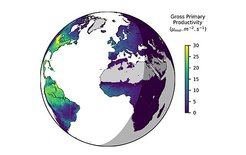Together more successful: Computer scientists and ecologists investigate changes in ecosystems

Climate change and the associated intensification of extreme meteorological events on the one hand, and rapid land-use changes on the other, confront us with new global challenges. However, any strategy for nature conservation and landscape protection requires a solid basis of data. A new generation of European satellite observations - the so-called Sentinels - enables us to monitor the ecosystems of our globe with an unprecedented resolution in space and time. However, the huge amounts of incoming satellite data must be evaluated efficiently in order to detect changes in ecosystems early on. This is a challenging task that individual researchers cannot accomplish alone. Progress in this case can only be made if environmental scientists team up with computer scientists and remote sensing experts.
"The rapid development in computer science towards fully automated methods that detect anomalies in complex data is also a crucial step in environmental research", explains Dr. Miguel Mahecha, coordinator of the BACI project (Detecting changes in essential ecosystem and biodiversity properties - towards a Biosphere Atmosphere Change Index). But the chosen approach also opened up new perspectives for the computer scientists involved in the project. "We are pleased that our research makes a contribution to the environmental sciences", says Prof. Joachim Denzler. "Here we face new challenges that exceeded the capacity of existing methods. With the development of new algorithms, we have also taken an important step forward in our field", adds the Chair of Digital Image Processing at Friedrich Schiller University Jena and member of the Michael-Stifel Center Jena (MSCJ).
The joint project BACI, which was financed from the research and innovation program of the Euro-pean Commission Horizon 2020, can boast several success stories: The project succeeded in combining radar and optical data that contribute to, for instance, determining biodiversity patterns in European forest ecosystems. By combining satellite data and measurements of carbon dioxide exchange between ecosystems and the atmosphere using machine learning methods, it was, for the first time, possible to visualise the daily CO2 uptake of the entire Earth. Also, it has also been possible to predict the values of tree rings using artificial intelligence methods. Most of these breakthroughs were only possible due to unconventional ways of using artificial intelligence methods to answer ecological questions.
“The future of environmental research is data-driven and unthinkable without advances in computer science”, Mahecha sums up.
Contact at Max Planck Institute for Biogeochemistry
Dr. Miguel Mahecha, Group Leader Empirical Interference of the Earth System
Phone: +49 (0)3641 576265
Email: mmahecha@bgc-jena.mpg.de
For more information please visit BACI’s webpage and twitter (see links below).
